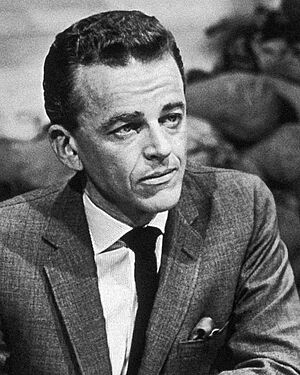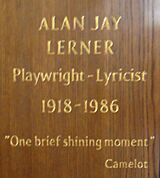Alan Jay Lerner facts for kids
Quick facts for kids
Alan Jay Lerner
|
|
|---|---|

Lerner, c. 1962
|
|
| Background information | |
| Born | August 31, 1918 New York City, US |
| Died | June 14, 1986 (aged 67) New York City, US |
| Genres | Musical theatre, popular |
| Occupations | Lyricist, librettist |
| Years active | 1942–1986 |
Alan Jay Lerner (born August 31, 1918 – died June 14, 1986) was an American writer for musicals. He wrote the words for songs (a lyricist) and the stories for musicals (a librettist). He worked with Frederick Loewe and later Burton Lane. Together, they created some of the most famous musicals for both the stage and movies. Lerner won many awards, including three Tony Awards and three Academy Awards.
Contents
Early Life and Education
Alan Jay Lerner was born in New York City. His parents were Edith and Joseph Lerner. His family owned a chain of dress shops called Lerner Stores. Alan went to school in England at Bedales School. He also studied at The Choate School and Harvard University in the United States. At both Choate and Harvard, he was classmates with John F. Kennedy, who later became president. They even worked on the yearbook together.
Lerner's journey into musical theater began in college. He wrote for the annual Harvard Hasty Pudding Theatricals musicals. In the summers of 1936 and 1937, he studied music at Juilliard. While at Harvard, he had an accident in a boxing ring. This accident caused him to lose sight in his left eye.
A Career in Musicals
Because of his eye injury, Lerner could not serve in World War II. Instead, he wrote radio scripts. One show he worked on was Your Hit Parade. In 1942, he met Frederick Loewe, an Austrian composer. Loewe was looking for a partner, and they began working together.
Early Shows with Loewe
Lerner and Loewe's first musical together was Life of the Party in 1942. It was a funny show that ran for nine weeks. This success encouraged them to create more musicals. Their next show, What's Up?, opened on Broadway in 1943. It was followed by The Day Before Spring two years later.
Their first big success was Brigadoon in 1947. This was a romantic story about a magical Scottish village. In 1951, they created Paint Your Wagon. This musical was about the California Gold Rush. It ran for almost a year and included popular songs like "They Call the Wind Maria".
Working on Films and Big Hits
Lerner also worked with other composers. He wrote the musical Love Life (1948) with Kurt Weill. He also worked with Burton Lane on the movie musical Royal Wedding (1951). In the same year, Lerner wrote the story for the movie An American in Paris. This movie won an Oscar for its original story.
In 1956, Lerner and Loewe created their most famous musical, My Fair Lady. This show was based on George Bernard Shaw's play Pygmalion. It told the story of Henry Higgins and Eliza Doolittle. The original stars were Rex Harrison and Julie Andrews. My Fair Lady broke box-office records in New York and London. When it became a movie in 1964, it won eight Oscars, including Best Picture.
Their success continued with the film Gigi in 1958. This movie musical won all nine of its Oscar nominations. This was a record at the time.
Later Works and Challenges
Lerner and Loewe's next big project was Camelot in 1960. This musical was about King Arthur. It was a hit, even though they faced challenges during its creation. After President John F. Kennedy was assassinated, his wife said that his time in office reminded her of the "one brief shining moment" from Camelot.
After Camelot, Loewe retired for a while. Lerner worked on other musicals with different composers. These included Coco with André Previn and On a Clear Day You Can See Forever with Burton Lane. On a Clear Day You Can See Forever was also made into a movie in 1970.
In 1973, Lerner convinced Loewe to work with him again. They adapted their movie Gigi into a stage musical. The next year, they created a musical film version of The Little Prince. This film was not a big success at first, but it later gained fans.
How He Wrote Songs
Writing lyrics was often hard for Lerner. He once wrote the song "I Could Have Danced All Night" from My Fair Lady in just 24 hours. But usually, he spent months on each song. He was always rewriting them to make them perfect.
Lerner explained his songwriting process:
- First, he and the composer decided where a song was needed in the play.
- Second, they decided what the song would be about.
- Third, they talked about the mood of the song.
- Fourth, Lerner gave the composer a title.
- Then, the composer wrote the music for that title and feeling.
- Finally, Lerner wrote the lyrics to the melody.
He once shared a funny story about a line in My Fair Lady. Professor Henry Higgins sings, "By right she should be taken out and hung / For the cold-blooded murder of the English tongue." Lerner knew that "hung" was not the correct word for a person (it should be "hanged"). But he used it because it rhymed better.
Personal Life
Alan Jay Lerner was married eight times. He had four children: three daughters named Susan, Liza, and Jennifer, and one son named Michael.

Lerner faced financial difficulties during his life. He died from lung cancer on June 14, 1986, in Manhattan. He was 67 years old. He has a special memorial plaque in St Paul's Church in London, which is known as the Actors' Church.
Awards and Honors
Alan Jay Lerner received many awards for his work:
- American Theater Hall of Fame (1979)
- Kennedy Center Honors (1985)
Academy Awards
- Best Original Screenplay, 1951 for An American in Paris
- Best Adapted Screenplay, 1958 for Gigi
- Best Original Song, 1958 for Gigi
Golden Globes
- Best Original Song, 1968 for Camelot
- Best Original Score, 1975 for The Little Prince
Tony Awards
- Best Book of a Musical, 1957 for My Fair Lady
- Best Original Score, 1957 for My Fair Lady
- Best Original Score, 1974 for Gigi
Other Awards
- Best Musical, 1947 for Brigadoon
- Best Musical, 1956 for My Fair Lady
- Johnny Mercer Award for Lyric Writing, 1985
Works
Stage Musicals
- Life of the Party (1942), with Frederick Loewe
- What's Up? (1943), with Frederick Loewe
- The Day Before Spring (1945), with Frederick Loewe
- Brigadoon (1947), with Frederick Loewe
- Love Life (1948), with Kurt Weill
- Paint Your Wagon (1951), with Frederick Loewe
- My Fair Lady (1956), with Frederick Loewe
- Camelot (1960), with Frederick Loewe
- On a Clear Day You Can See Forever (1965), with Burton Lane
- Coco (1969), with André Previn
- Lolita, My Love (1971), with John Barry
- Gigi (1973), based on the 1958 film of the same name, with Frederick Loewe
- 1600 Pennsylvania Avenue (1976), with Leonard Bernstein
- Carmelina (1979), with Burton Lane and Joseph Stein
- Dance a Little Closer (1983), with Charles Strouse
Films
- Royal Wedding, 1951 (screenwriter/lyricist)
- An American in Paris (1951) (writer)
- Brigadoon, 1954 (screenwriter/lyricist)
- Gigi, 1958 (screenwriter/lyricist)
- The Adventures of Huckleberry Finn, 1960 (lyricist)
- My Fair Lady, 1964 (screenwriter/lyricist)
- Camelot, 1967 (screenwriter/lyricist)
- Paint Your Wagon, 1969 (producer/screenwriter/lyricist)
- On a Clear Day You Can See Forever, 1970 (screenwriter/lyricist)
- The Little Prince, 1974 (screenwriter/lyricist)
- Tribute, 1980 ("It's All for the Best", lyricist)
- Secret Places, 1984 (title song lyricist)
See also
 In Spanish: Alan Jay Lerner para niños
In Spanish: Alan Jay Lerner para niños

